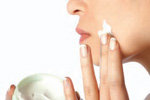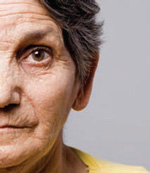The Pharmacist’s guide to skin health from newborns to seniors
The primary function of the skin is to protect the body from unwanted influences from the environment.(1) The stratum corneum, the foremost barrier of the skin, consists of corneocytes surrounded by lipid regions. Products and medicines applied onto the skin permeate along the lipid domains. The lipid composition of the stratum corneum is unique, comprised of long chain ceramides, free fatty acids and cholesterol in a lipid organization that is different from that of other biological membranes and which contributes to the permeability barrier function of the skin.
The thickness, resilience and elasticity of this protective layer changes at several points during our lives. Anyone who has seen a newborn knows that we are born with a fine, delicate stratum corneum. As we mature and our skin is exposed to the elements, it becomes more resilient. And as we age, our skin grows thinner and less elastic, and loses the protective layer of cushioning fat that gives younger skin its resilience. For these reasons, skin requires different attention and care at various stages of our lives.
Skincare basics for newborns
For newborn skin, the ideal cleansing product is actually plain, pure bath water. But when caregivers prefer to use products, recommend that they select mild, neutral-pH cleansers without dyes or fragrances.(2) Any products applied to newborn skin should be used sparingly and rinsed off completely.

Diaper rash
Diaper rash, also known as diaper dermatitis, is caused by contact with wet or soiled diapers and occurs when urine or stool irritates the baby’s skin, making it tender and red. Diaper rash can be prevented by following a few guidelines:
The use of wipes can dry out a baby’s tender skin. If pre-moistened wipes are used, ensure that they are alcohol-free and unscented (e.g., Huggies Natural Care Baby Wipes, Johnson’s Baby Gentle Cleansing Wipes) and avoid the use of baby powder or talc.(3)
In cases of diaper rash, recommend the application of zinc oxide paste with a neutral pH (Penaten, Zincofax) to act as a barrier between the acidic products of urine and stool and the baby's skin.(3) It takes a few days for diaper rash to resolve with this treatment; however, if the zinc oxide product doesn't clear it up after several days, suggest a consult with a qualified healthcare provider to determine if the rash might need more aggressive treatment, or whether it may be candida rash. Caused by the fungus of the same name, candida rash appears near the genitals and buttocks, and the skin presents as very red, with small red spots close to large patches. Treatment with a prescribed antifungal cream is required.
- change baby’s diaper often (every two to four hours or after baby has soiled),
- keep the diaper off for short periods of time to allow the skin to air dry,
- wash the area well with mild soap and warm water, rinse and let dry completely with each diaper change, and
- apply unscented petroleum jelly or a paste/cream with zinc oxide to protect and lubricate.
Cradle cap
Cradle cap, a form of seborrheic dermatitis in infants, presents with flaking or scaling of the skin on the scalp, which may also be reddened; it is generally nonpruritic. Left untreated, it usually resolves at 8 months and doesn’t bother the infant.(4)
If parents need to do something, recommend mineral oil and gentle brushing to loosen the scales. Application of a small amount of mineral oil onto scales, followed by shampooing and brushing out the oil approximately one hour later is suggested. When applying the oil, rub only small amounts into the scales. Canadian Dermatology Association patient information on childhood eczema states cradle cap is harmless and usually clears up by age 1 year on its own.(5)
Basic adult skincare
As skin matures with us from early to late adulthood, the primary areas of concern for skincare are hydration, photoprotection, skin aging, skin reactivity and hyperpigmentation, thinning skin and overall skin health.
(protecting the skin from harmful UV rays).

Cleansing
It is commonly known that cleansing is an important part of good skin care. But while cleansers are intended to help prevent blockage of pores as well as remove dirt, germs, excess oils, and make-up or similar products on the skin, some cleansers can also have damaging effects on the skin. Cleansing routines can cause dry skin where skin is not normally dry. Advise clients to select clinically proven effective non-irritating, non-drying skin cleansing products (e.g., Cetaphil cleansers).
Exfoliation and toner use
The accumulation of dead cells contributes to blocked pores; exfoliating is the process of removing these dead skin cells. Exfoliators comprise two general classes: mechanical and chemical. Mechanical exfoliation, in the form of facial scrubs, help exfoliate the surface of the skin by mechanically removing the dead skin. Chemical exfoliators contain alpha hydroxy acids (AHAs), such as glycolic and salicylic acid, beta hydroxy acids or retinoic acid (retinol) which act more like a “peel.”
Most dermatologists prefer chemical exfoliating agents since they penetrate deeper and stimulate cell renewal as well as collagen synthesis. Most skin types benefit from a gentle to moderate exfoliation; the exceptions are patients with sensitive and/or dry skin, which may not tolerate chemical exfoliation.
In addition, the facial skin can be toned with products that have glycolic or alpha hydroxy acids. This helps remove residual cleanser and/or make-up, restores the natural pH level of the skin, and generally leaves the skin clean, clear and ready to be hydrated. Applying toner closes pores, tightens skin, and provides protection from toxins and other environmental pollutants.
Moisturizing
Moisturizing is considered an essential component of good skincare. A good moisturizer can prevent dry skin from worsening into cracked, flaky skin. Effective moisturizers have a combination of ingredients that work together to help replenish the skin's natural ingredients and thereby help maintain the skin’s structure, reduce free-radical damage and help maintain normal cell function.
Complex science underpins the new state-of-the-art moisturizers, which include ingredients such as
- glycerol to help ingredients penetrate the skin,
- ceramides to help replenish the skin's natural oils,
- hydroxy acids to help to exfoliate dead skin cells, and
- niacinamide to help the skin produce more natural oils (may also help reverse the signs of sun-damaged skin, such as brown spots).
Select moisturizers that provide long-lasting skin hydration and help restore the skin's natural protective barrier (e.g., Cetaphil cream or lotion).
Apply sunscreen
Sunscreens absorb or reflect the sun's ultraviolet (UV) rays. Sunscreens not only help protect the skin from sunburn but also from chronic sun damage. Commonly, skin damage from UV radiation occurs beneath the skin’s surface and happens so gradually that the amount of damage is imperceptible. While most people now appreciate and understand that exposure to UV radiation may cause damage to the skin, including sunburn, photoaging, and increased risk of skin cancer, fewer understand that this damage also occurs with minimal everyday exposure, such as walking from the house to the car, or sitting next to a window during the day. Even small exposures add up, and over the years may cause wrinkles, dark spots and skin cancer. When selecting a sunscreen, it is important to choose one that protects from both UVB and UVA radiation. Selecting a good sunscreen, and making its application a part of daily routine, is as important as brushing teeth and bathing.
Recently, Health Canada replaced the 2006 Sunburn Protectants Monograph with a Draft: Guidance Document—Sunscreen Monograph.(7) When used as a single medicinal ingredient, sunscreen ingredients must meet the critical wavelength requirement of at least 370 nm and the minimum sun protection factor (SPF) value of 15. Ingredients not meeting these requirements must always be used in combination with other medicinal ingredients. Currently in Canada, sunscreens are classified as natural health products if they contain the ingredients titanium dioxide (TiO2), zinc oxide (ZnO) and para-aminobenzoic acid, or as drugs if they contain ingredients such as avobenzone, ensulizole or dioxybenzone.
Newer sunscreen ingredients, such as mexoryl hinder ultraviolet A and B light, provide improved photostability and enhanced water resistance, potentially reducing and preventing biochemical changes that can lead to nonmelanoma carcinoma and physiognomies of skin aging.(8,9) Sun protection products must be selected carefully for people with sensitive skin, sun intolerance or those who may be exposed to intense sun regularly (e.g., Anthelios by LaRoche-Posay).(10)
For all products containing (nonmedicinal) AHAs, such as glycolic acid and lactic acid at concentrations ranging from 1%-3%, and/or retinol (or its derivatives, such as retinal acetate and retinal palmitate) at concentrations ranging from 0.1%-1.0%, there is a potential for increased skin sensitivity to the sun and particularly sunburn. It is suggested sun exposure be limited for a week after use of these products.(7)
Scars and stretch marks
Scars are an integral part of the healing process and go through numerous changes as they mature, but a scar is permanent in nature. When a body expands quickly and more importantly, faster than the covering skin, the skin tears and may form a scar as it heals. Some scars may be visible on the surface of the skin and are referred to as stretch marks.
The likelihood of developing stretch marks varies according to skin type, race, age, diet and hydration of the skin. Those most prone to stretch marks include pregnant women, body builders, adolescents undergoing sudden growth spurts and individuals who experience rapid or large amounts of weight gain. Dermal and epidermal tearing occurs as skin, lacking in fibroblast formation of collagen and elastin fibres, stretches.
Some products help reduce the appearance of stretchmarks. For example, Bio-Oil is a skincare oil that has been shown to be helpful in improving the appearance of scars, stretch marks, uneven skin tone as well as aging and dehydrated skin.
 Protect your skin from the sun
Protect your skin from the sunSun protection is one of the most important ways to take care of skin. A lifetime of sun exposure may case wrinkles, age spots and similar skin problems, and increases the risk of cancer. Apply a generous amount of broad-spectrum sunscreen with SPF 15 or greater, reapply often (every 2-4 hours), seek shade, avoid mid-day sun (10:00AM to 4:00PM), and wear wide brimmed hats, long sleeved shirts and long pants as much as possible.
- Know your skin type
Choose cleansing and skincare products specially designed for your skin type.
 Pay careful attention to sensitive areas
Pay careful attention to sensitive areasAreas such as the eye contour and the lips are more sensitive and deserve special attention.
 Be gentle to your skin
Be gentle to your skinSelect mild cleansers over strong soaps and detergents which may strip the skin of oil and other important nutrients. When shaving, use a clean, sharp razor and shave in the direction the hair grows, not against it. Facial skincare begins with make-up removal using formulations to cleanse the epidermis gently.
- Exfoliate
Use an effective yet gentle exfoliation treatment daily or at least once or twice a week.
- Moisturize
Moisturizing is essential. It is important to choose moisturizing skin care products that balance the level of water within the skin.
 Remember your lips!
Remember your lips!Use a restorative cream for the lips, reapplying as often as necessary.
- Stress management
A healthy state of mind encourages healthy skin. Stress that is consistent and uncontrolled may cause increased skin sensitivity and trigger skin break outs. Take steps to manage stress and the results may be more dynamic than expected.
 Don’t smoke
Don’t smokeSmoking contributes to wrinkles and makes skin look old. Smoking causes narrowing of the blood vessels in the outermost layer of the skin, which in turn decreases blood flow, depleting oxygen and nutrients that are important to skin health. Smoking also damages collagen and elastin, and the repetitive facial expressions made when smoking (pursing your lips when inhaling, squinting eyes to keep out smoke) contributes to wrinkles.
 Eat a healthy diet
Eat a healthy dietA healthy diet, based primarily of consumption of vegetables, whole grains, lean proteins and fruit improves overall skin health. Avoid unhealthy fats and refined or processed carbohydrates.
How aging changes skin
To promote healthy aging, it is important to understand the skin changes associated with this phase of life. Regular skin examinations by a knowledgeable healthcare provider can substantially improve the quality of life among adult patients.
Two didactically independent, clinically and biologically distinct processes are factors in skin aging(11): Intrinsic skin aging characterizes chronological aging and affects skin in the same way it affects all internal organs. Extrinsic skin aging (aged skin) is the result of external factors and environmental influence, mainly chronic sun exposure and UV irradiation but also smoking, pollution, sleep deprivation and poor nutrition. Prevention strategies against extrinsic skin aging effects involve avoidance of the harmful action of free radicals with balanced nutrition (including a diet rich in antioxidant nutrients), a balanced lifestyle (caloric restriction, body care and physical exercise) and low stress.
With aging, skin becomes lax, wrinkled and much easier to tear.(12) The epidermis thins in some areas. Thermoregulation capability is weakened and the microscopic structure of the tissue (histology) changes. There is retraction of the epithelial extensions (rete pegs), which hold the epidermis to the dermis that project into the underlying connective tissue. The stratum corneum—which protects underlying tissue from infection, dehydration, chemicals and mechanical irritation and is also responsible of corneum lipid biosynthesis—becomes compromised. The consequence is impaired permeability barrier function. Diseased skin is often characterized by a reduced barrier function, and an altered lipid composition and organization. The number of sweat glands, subcutaneous fat, cutaneous blood flow and maintenance and remodelling of microvasculature also decreases as we age.
Ultraviolet radiation activates signalling pathways that result in the degradation of the extracellular matrix.(12) Chronic UV exposure leads to progressive loss of cutaneous vasculature, cumulative damage of the skin known as photoaging, and seems to affect similar cellular mechanisms as chronological aging.
Estrogen hormone therapy has been shown to restore skin collagen, thickness and moisture content and ameliorates skin aging and wrinkling.(12) It is important to remember that while hormone therapy increases bone density and reduces the risk of osteoporotic fracture, it is also known to increase the risk of coronary heart disease, stroke, thromboembolic events and breast cancer.
Barrier function research has identified active agents that promote hydration of the skin, strengthening the barrier function, the maintenance of epidermal homeostasis, resistance to various stresses, protection against external pathogens, cell repair and tissue regeneration.(12)
Elderly Skin Care

Pruritus
Pruritus, the causes for which are multiple, is a common skin complaint in geriatrics. Attending physicians execute thorough medical examinations for pruritus of unknown etiology. While there may be an underlying skin disease (zerosis, seborrheic dermatitis), repeated scratching may lead to lichenifiation, excoriation, infection and traumatic purpura. Typically, pruritus is related to xerosis (dryness of the skin) and topical moisturizers are the preferred treatment. Combination products that hydrate and hold water in the skin (such as Glaxal Base Lotion or Cream) are suggested for relief.
Contact dermatitis
A prevalent condition in the elderly population, early disease may be differentiated by symptoms and histology.(12) Irritant contact dermatitis (where a person complains of burning and stinging sensations) is nonimmunologically mediated whereas allergic dermatitis (pruritis) is immunologically mediated. With disease progression, it becomes increasingly difficult to differentiate the two types. Overall, the incidence of allergic-type contact dermatitis decreases with age. However some allergies, such as to fragrance, increase with advancing age. Worsening allergies should be investigated to ascertain the culprit and once established, careful avoidance may be required for up to 3 months before clinical improvements are observed.
Conclusion
Each phase of life brings with it unique skincare concerns and needs. It's important for healthcare providers who interact with and counsel their patients to be able to identify common needs and dermatological problems.
—Rhonda Dorren is a clinical pharmacist and educator.
| table 1 Natural Health Products Sunscreen Medicinal Ingredients and Source Materials | |||||||||||||||||||||
| |||||||||||||||||||||
| table 2 Drugs Sunscreen Medicinal Ingredients and Source Materials | ||||||||||||||||||||||||||||||||||||||||||||||||||||||||||||||||||||||||||||||||||||
| ||||||||||||||||||||||||||||||||||||||||||||||||||||||||||||||||||||||||||||||||||||
References
- Bouwstra JA, Ponec M. The skin barrier in healthy and diseased state. Biochim Biophys Acta 2006;1758(12):2080-95
- Mayo clinic expert suggests proper techniques for newborn bathing and skin care basics. Available from: www.mayoclinic.org/news2013-rst/7278.html (accessed April 23, 2013).
- Canadian Paediatric Society. Skin care for your baby. Paediatr Child Health 2007;12(3): 245-7.
- Sheffield RC, Crawford P, Wright ST. What’s the best treatment for cradle cap? March 2007,56(3):232-233
- Childhood eczema. Ottawa, ON: Canadian Dermatology Association; 2013. Available from www.dermatology.ca/skin-hair-nails/skin/eczema/childhood-eczema (accessed April 23, 2013).
- MacNeal RJ. Overview of effects of sunlight. In: The Merck manual for health care professionals. Available from: www.merckmanuals.com/professional/dermatologic_disorders (accessed April 23/2013).
- Draft: Guidance document—sunscreen monograph. Drugs and Health Products. Ottawa, ON: Health Canada; 2013. Available from www.hc-sc.gc.ca/dhp-mps/consultation/natur/sunscreen-ecransolaire-eng.php (accessed April 23,2013).
- D'Souza G, Evans GR; Plastic Surgery Educational Foundation Technology Assessment Committee. Plast Reconstr Mexoryl: a review of an ultraviolet a filter. Surg 2007;120(4):1071-5.
- Medeiros VL, Lim HW. Sunscreens in the management of photodermatoses. Skin Therapy Lett 2010;15(6):1-3.
- Anthelios. La Roche Posay. Available from: www.laroche-posay.co.uk/product-treatments/Anthelios/Sun-for-everyone-r64.aspx (accessed April 23, 2013).
- Schagen KS, Zampeli VA, Makrantonaki E, et al. Discovering the link between nutrition and skin aging. Dermatoendocrinol 2012;4(3):298-307.
- Na CR, Wang S, Kirsner RS, et al. Elderly adults and skin disorders: common problems for nondermatologists. South Med J 2012;105(11):600-6.
